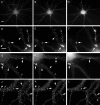GABAergic innervation organizes synaptic and extrasynaptic GABAA receptor clustering in cultured hippocampal neurons
- PMID: 11826098
- PMCID: PMC6758471
- DOI: 10.1523/JNEUROSCI.22-03-00684.2002
GABAergic innervation organizes synaptic and extrasynaptic GABAA receptor clustering in cultured hippocampal neurons
Abstract
We have studied the effects of GABAergic innervation on the clustering of GABA(A) receptors (GABA(A)Rs) in cultured hippocampal neurons. In the absence of GABAergic innervation, pyramidal cells form small (0.36 +/- 0.01 micrometer diameter) GABA(A)R clusters at their surface in the dendrites and soma. When receiving GABAergic innervation from glutamic acid decarboxylase-containing interneurons, pyramidal cells form large (1.62 +/- 0.08 micrometer breadth) GABA(A)R clusters at GABAergic synapses. This is accompanied by a disappearance of the small GABA(A)R clusters in the local area surrounding each GABAergic synapse. Although the large synaptic GABA(A)R clusters of any neuron contained all GABA(A)R subunits and isoforms expressed by that neuron, the small clusters not localized at GABAergic synapses showed significant heterogeneity in subunit and isoform composition. Another difference between large GABAergic and small non-GABAergic GABA(A)R clusters was that a significant proportion of the latter was juxtaposed to postsynaptic markers of glutamatergic synapses such as PSD-95 and AMPA receptor GluR1 subunit. The densities of both the glutamate receptor-associated and non-associated small GABA(A)R clusters were decreased in areas surrounding GABAergic synapses. However, no effect on the density or distribution of glutamate receptor clusters was observed. The results suggest that there are local signals generated at GABAergic synapses that induce both assembly of large synaptic GABA(A)R clusters at the synapse and disappearance of the small GABA(A)R clusters in the surrounding area. In the absence of GABAergic innervation, weaker GABA(A)R-clustering signals, generated at glutamatergic synapses, induce the formation of small postsynaptic GABA(A)R clusters that remain juxtaposed to glutamate receptors at glutamatergic synapses.
Figures







References
-
- Araujo F, Tan S, Ruano D, Schoemaker H, Benavides J, Vitorica J. Molecular and pharmacological characterization of native cortical gamma-aminobutyric acidA receptors containing both alpha1 and alpha3 subunits. J Biol Chem. 1996;271:27902–27911. - PubMed
-
- Araujo F, Ruano D, Vitorica J. Native gamma-aminobutyric acid type A receptors from rat hippocampus, containing both alpha 1 and alpha 5 subunits, exhibit a single benzodiazepine binding site with alpha 5 pharmacological properties. J Pharmacol Exp Ther. 1999;290:989–997. - PubMed
-
- Bacci A, Coco S, Pravettoni E, Schenk U, Armano S, Frassoni C, Verderio C, De Camilli P, Matteoli M. Chronic blockade of glutamate receptors enhances presynaptic release and downregulates the interaction between synaptophysin-synaptobrevin–vesicle-associated membrane protein 2. J Neurosci. 2001;21:6588–6596. - PMC - PubMed
-
- Backus KH, Arigoni M, Drescher U, Scheurer L, Malherbe P, Mohler H, Benson JA. Stoichiometry of a recombinant GABAA receptor deduced from mutation-induced rectification. NeuroReport. 1993;5:285–288. - PubMed
Publication types
MeSH terms
Substances
Grants and funding
LinkOut - more resources
Full Text Sources
